
Data sheet
Cisco Public
Cisco Catalyst 9800-40
Wireless Controller
Built from the ground up for intent-based
networking
© 2020 Cisco and/or its affiliates. All rights reserved.
Page 1 of 20

Contents
Product overview
3
Features
4
Details
5
Benefits
11
Specifications
13
Software requirements
17
Licensing
17
Warranty
19
Cisco environmental sustainability
19
Ordering information
20
Cisco Capital
20
© 2020 Cisco and/or its affiliates. All rights reserved.
Page 2 of 20
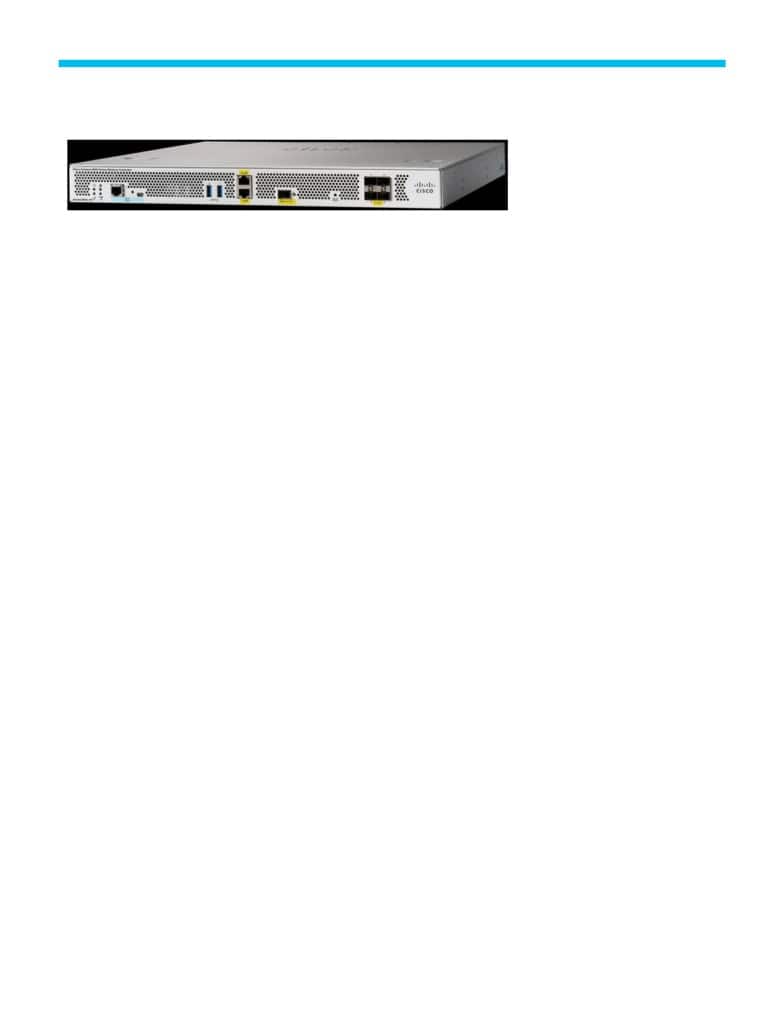
Product overview
Figure 1.
Cisco Catalyst 9800-40 Wireless Controller
Built from the ground-up for intent-based networking and Cisco DNA, Cisco® Catalyst® 9800 Series Wireless
Controllers are Cisco IOS® XE based and integrate the RF excellence of Cisco Aironet® access points, creating a
best-in-class wireless experience for your evolving and growing organization. The 9800 Series is built on an
open and programmable architecture with built-in security, streaming telemetry, and rich analytics.
The Cisco Catalyst 9800 Series Wireless Controllers are built on the three pillars of network excellence— always
on, secure, and deployed anywhere—which strengthen the network by providing the best wireless experience
without compromise, while saving time and money.
The Cisco Catalyst 9800-40 is a fixed wireless controller with seamless software updates for midsize and large
enterprises. It is feature rich and enterprise ready to power your business-critical operations and transform
end-customer experiences:
●
High availability and seamless software updates, enabled by hot and cold patching, keep your
clients and services always on during planned and unplanned events.
●
Secure air, devices, and users with the Cisco Catalyst 9800-40. Wireless infrastructure becomes
the strongest first line of defense with Cisco Encrypted Traffic Analytics (ETA) and Software-Defined
Access (SD-Access). The controller comes with built-in security: Secure Boot, runtime defenses,
image signing, integrity verification, and hardware authenticity.
●
Built on a modular operating system, the 9800-40 features open and programmable APIs that
enable automation of day-0 to day-N network operations. Model-driven streaming telemetry
provides deep insights into the health of your network and clients.
●
Cisco User Defined Network, a feature available in Cisco DNA Center, allows IT to give end users
control of their very own wireless network partition on a shared network. End users can then
remotely and securely deploy their devices on this network. Perfect for university dormitories or
extended hospital stays, Cisco User Defined Network grants both device security and control,
allowing each user to choose who can connect to their network. (Available second half of calendar
year 2020.)
●
The Wi-Fi 6 readiness dashboard is a new dashboard in the Assurance menu of Cisco DNA Center.
It will look through the inventory of all devices on the network and verify device, software, and client
compatibility with the new Wi-Fi 6 standard. After upgrading, advanced wireless analytics will
indicate performance and capacity gains as a result of the Wi-Fi 6 deployment. This is an incredible
tool that will help your team define where and how the wireless network should be upgraded. It will
also give you insights into the access point distribution by protocol (802.11 ac/n/abg), wireless
airtime efficiency by protocol, and granular performance metrics.
●
With Cisco In Service Software Upgrade (ISSU), network downtime during a software update or
upgrade is a thing of the past. ISSU is a complete image upgrade and update while the network is
© 2020 Cisco and/or its affiliates. All rights reserved.
Page 3 of 20

still running. The software image—or patch—is pushed onto the wireless controller while traffic
forwarding continues uninterrupted. All access point and client sessions are retained during the
upgrade process. With just a click, your network automatically upgrades to the newest software.
Features
Table 1. Key features
Metric
Value
Maximum number of access points
Up to 2000
Maximum number of clients
32,000
Maximum throughput
Up to 40 Gbps
Maximum WLANs
4096
Maximum VLANs
4096
Maximum site tags
2000
Maximum Flex® APs per site
100
Maximum policy tags
2000
Maximum RF tags
2000
Maximum RF profiles
4000
Maximum policy profiles
1000
Maximum Flex profiles
2000
Interfaces
4x 10G/1x 1G SFP+/SFP
Power supply
AC power with optional redundant AC power
Maximum power consumption
381W
Deployment modes
Centralized, Cisco FlexConnect®, and Fabric Wireless (SD-
Access)
Form factor
1RU
License
Smart License enabled
Operating system
Cisco IOS XE
Management
Cisco DNA Center, Cisco Prime® Infrastructure, integrated
WebUI, and third party (open standards APIs)*
© 2020 Cisco and/or its affiliates. All rights reserved.
Page 4 of 20
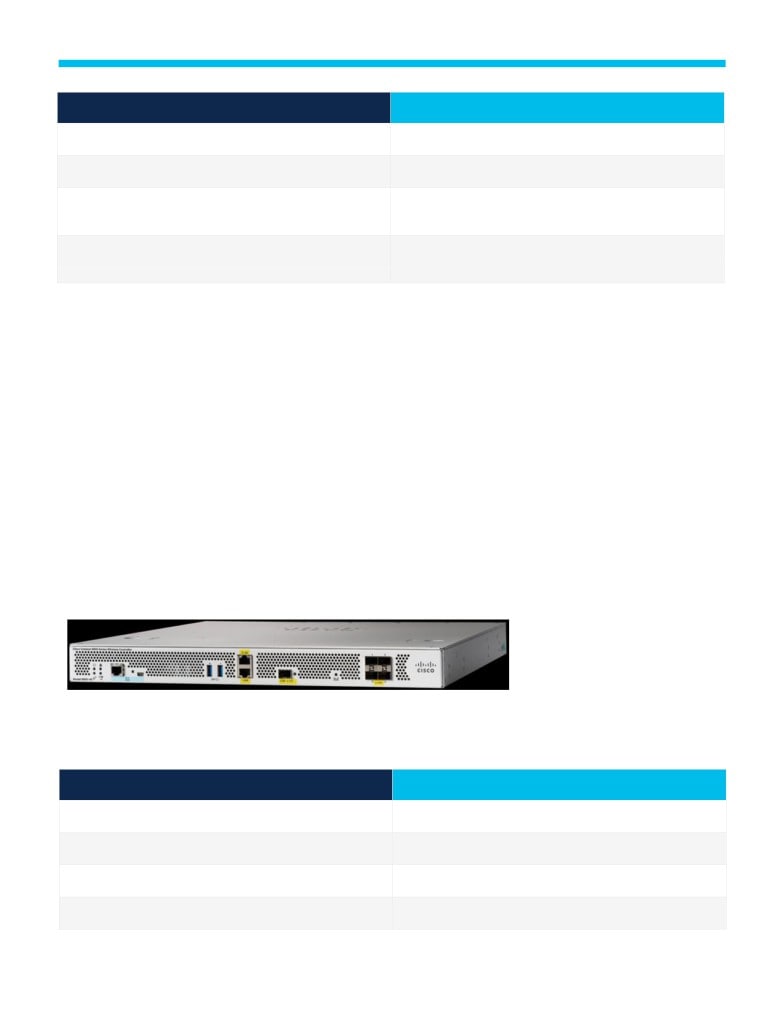
Metric
Value
Interoperability
AireOS-based controllers*
Policy engine
Cisco Identity Services Engine (ISE)*
Location platform
Cisco Connected Mobile Experiences (CMX), Cisco DNA
Spaces*
Access points
Aironet 802.11ac Wave 1 and Wave 2 access points, Cisco
Catalyst 9100 802.11ax access points
Always on
Seamless software updates enable faster resolution of critical issues, introduction of new access points with
zero downtime, and flexible software upgrades. Stateful switchover (SSO) with 1:1 active standby and N+1
redundancy keeps your network, services, and clients always on, even in unplanned events.
Secure
Secure air, devices, and users with the Cisco Catalyst 9800-40 Wireless Controller. Wireless infrastructure
becomes the strongest first line of defense with ETA and SD-Access. The controller comes with built-in
security: Secure Boot, runtime defenses, image signing, integrity verification, and hardware authenticity.
Open and programmable
The controller is built on the Cisco IOS XE operating system, which offers a rich set of open standards-based
programmable APIs and model-driven telemetry that provide an easy way to automate day-0 to day-N network
operations.
Details
Physical dimensions
Table 2. Physical dimensions
Dimension
Value
Width
17.3 inches (43.94 cm)
Depth
19.5 inches (49.53 cm)
Height
1.72 inches (4.37 cm)
Weight
22.8 lb (10.34 kg)
© 2020 Cisco and/or its affiliates. All rights reserved.
Page 5 of 20
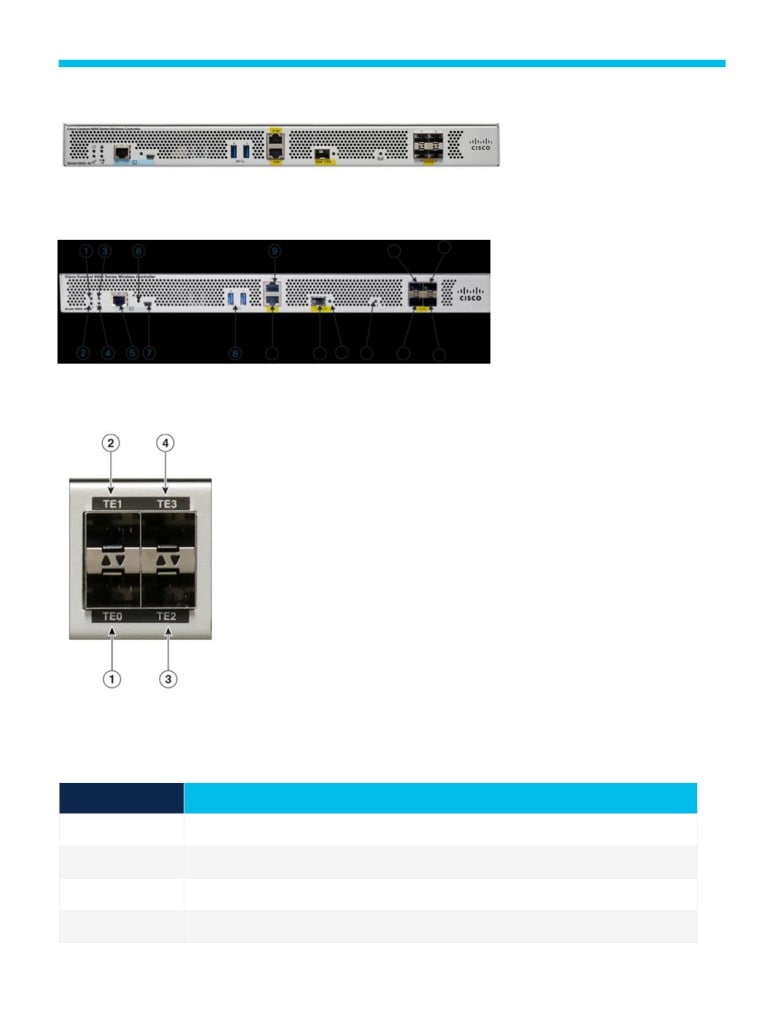
Front panel
Figure 2.
Front panel
Figure 3.
Front panel components
Figure 4.
10G/1G ports
Table 3. Descriptions of front panel components
Label
Component
1
PWR: Power LED
2
SYS: System LED
3
ALM: Alarm LED
4
HA: High-availability LED
© 2020 Cisco and/or its affiliates. All rights reserved.
Page 6 of 20

Label
Component
5
CON: RJ-45 compatible console port
6
EN: USB console-enabled LED
7
CON: Mini USB console port
8
USB ports 0 and 1
9
SP: RJ-45 10/100/1000 management Ethernet port
10
RP: RJ-45 10/100/1000 redundancy Ethernet port
11
RP: 1 GE SFP port (the only SFPs supported on the RP port are GLC-SX-MMD and GLC-LH-
SMD)
12
LINK: RJ-45 connector LED
13
SSD: SSD activity LED
14
TE0: 1 GE SFP/10 GE SFP+ port 0
15
TE1: 1 GE SFP/10 GE SFP+ port 1
16
TE2: 1 GE SFP/10 GE SFP+ port 2
17
TE3: 1 GE SFP/10 GE SFP+ port 3
Ports
Table 4.
Ports and their purpose
Port
Purpose
1x RJ-45 console
Console port for out-of-band management
port
1x USB 3.0 console
Console port for out-of-band management
port
2x USB 3.0 ports
USB 3.0 ports for plugging in external memory
1x RJ-45
Management port used for out-of-band management. Also known as service port
management port
1x RJ-45
Redundancy port used for SSO
redundancy port
1x SFP Gigabit
Redundancy port used for SSO
Ethernet
● Redundancy port used for SSO; works with Cisco supported SFPs (GLC-LH-SMD and GLC-SX-MMD) for RP
redundancy port
port
© 2020 Cisco and/or its affiliates. All rights reserved.
Page 7 of 20
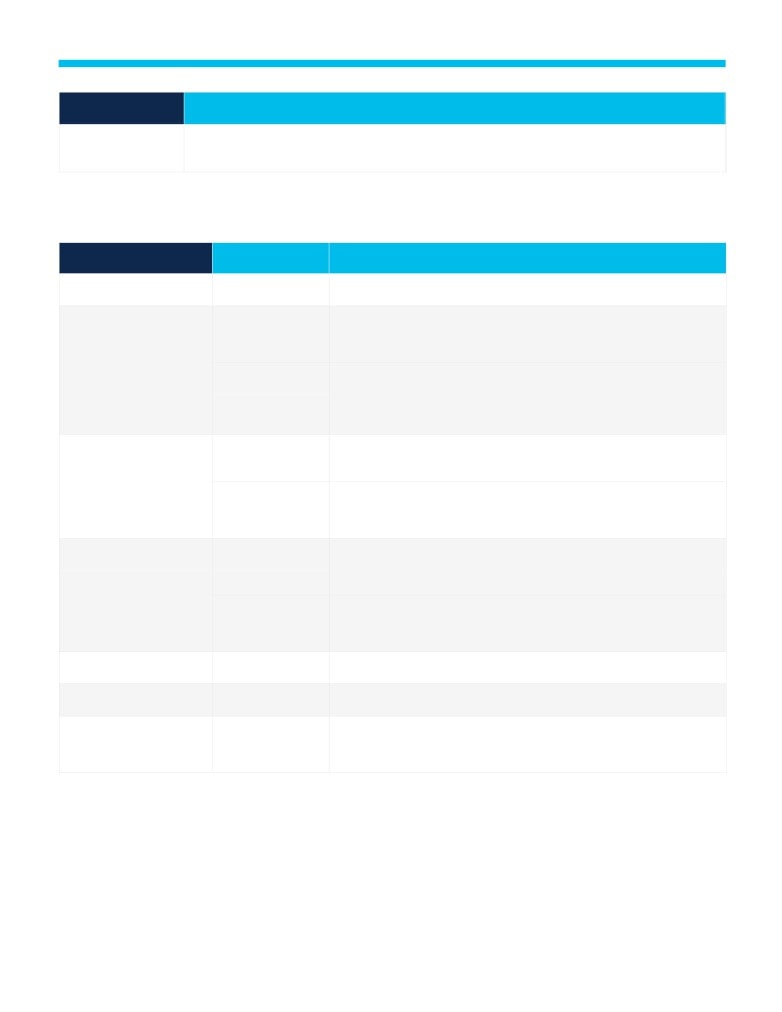
Port
Purpose
4x 10G/1G SFP+ or
Ports used for sending and receiving traffic between access points and controller, northbound
SFP ports
traffic, in-band management traffic, and wireless client traffic. Must be connected to the switch
Front panel LEDs
Table 5. Front panel LEDs
LED
Color
Function
Power
Green
Green if all power rails are within spec
System status
Green
On: IOS has boot complete
Blinking: IOS boot in progress
Amber
On: System crash
Blinking: Secure boot failure
Off: ROMMON boot
High Availability
Green
On: HA active
Blinking: HA standby hot
Amber
Slow blink: Booted with HA standby cold
Fast blink: HA maintenance
Alarm
Green
On: ROMMON boot complete
Blinking: System upgrade in progress
Amber
On: ROMMON boot and SYSTEM bootup
Blinking: Temperature err and secure boot failure
USB console
Green
When LED is lit, USB Console is enabled (RJ-45 console is disabled)
SSD activity
Green
Indicates active use of the hard disk SSD memory devices in the unit
Network link
Green
Solid green indicates link
Flashing green indicates activity
© 2020 Cisco and/or its affiliates. All rights reserved.
Page 8 of 20
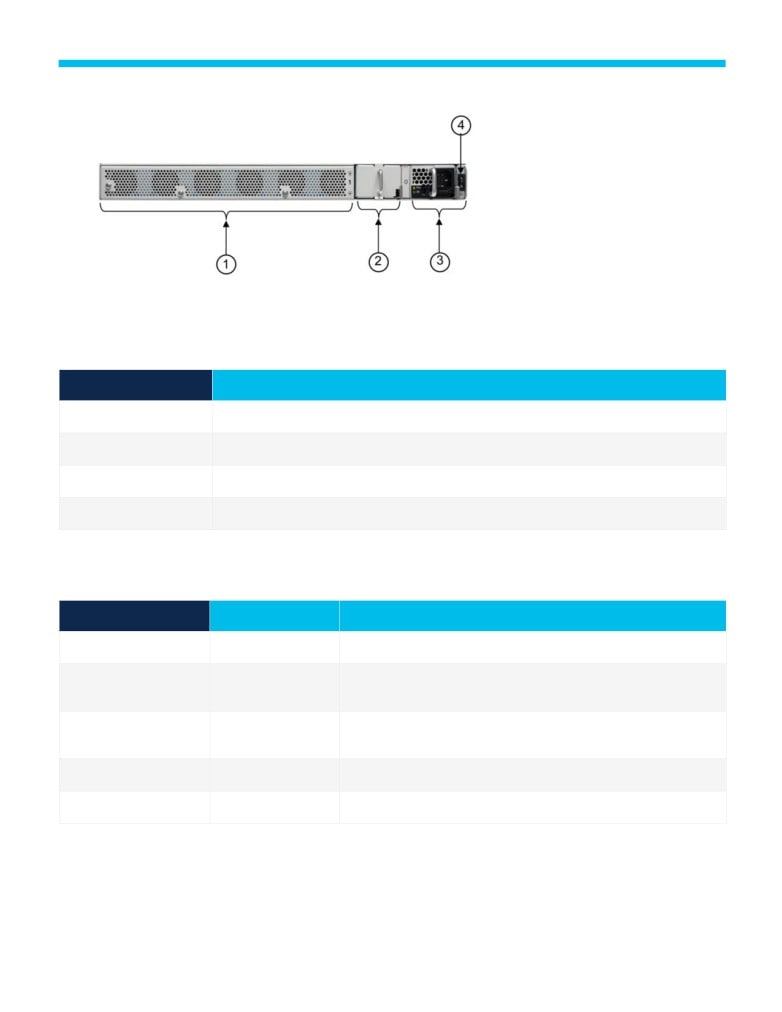
Rear panel
Figure 5.
Rear panel
Table 6. Descriptions of rear panel components
Label
Component
1
Fans
2
Optional redundant power supply (PEM 1)
3
Power supply (PEM 0)
4
Power/standby switch
Rear panel LEDs
Table 7. Power LEDs
Green LED
Amber LED
Power supply status
Off
Off
No AC power to all power supplies
Off
On
Power supply failure (includes over voltage, over current, over
temperature, and fan failure)
Off
1 Hz blinking
Power supply warning events in which the power supply continues to
operate (high temperature, high power, and slow fan)
1 Hz blinking
Off
AC present, 12VSB on (power supply off)
On
Off
Power supply on and OK
© 2020 Cisco and/or its affiliates. All rights reserved.
Page 9 of 20

Power
The 9800-40 controller supports an optional redundant AC power supply.
The AC input ranges are as follows:
● Worldwide ranging AC input range (90 to 264 VAC)
The power entry modules (PEMs) provide redundant power to the system, and the 9800-40 can operate
continuously with only a single PEM installed. The PEMs are hot-swappable, and replacement of a single PEM
can be made without power interruption to the system. All external connections to the PEMs are made from the
rear panel of the chassis, and they are removed or inserted from the rear. The main power switch for the unit is
located directly next to the PEMs on the rear of the chassis.
SFPs supported
The four data ports can operate in either 10G or 1G mode.
Note:
10/100-Mbps operation is not supported.
Table 8. SFPs supported
Type
Modules supported
Small Form-Factor Pluggable (SFP)
GLC-BX-D
GLC-BX-U
GLC-LH-SMD
GLC-SX-MMD
GLC-ZX-SMD
GLC-TE
Enhanced SFP (SFP+)
SFP-10G-SR
SFP-10G-SR-S
SFP-10G-SR-X
SFP-10G-LR
SFP-10G-LRM
SFP-10G-LR-X
SFP-10G-ER
SFP-10G-ZR
SFP-H10GB-ACU7M
© 2020 Cisco and/or its affiliates. All rights reserved.
Page 10 of 20

Type
Modules supported
SFP-H10GB-ACU10M
DWDM-SFP10G-30.33 - DWDM-SFP10G-61.41
Benefits
Cisco IOS XE opens a completely new paradigm in network configuration, operation, and monitoring through
network automation. Cisco’s automation solution is open, standards-based, and extensible across the entire
lifecycle of a network device. The various mechanisms that bring about network automation are outlined below,
based on a device lifecycle.
● Automated device provisioning: This is the ability to automate the process of upgrading software
images and installing configuration files on Cisco access points when they are being deployed in the
network for the first time. Cisco provides turnkey solutions such as Plug and Play (PnP) that enable
an effortless and automated deployment.
● API-driven configuration: Modern wireless controllers such as the Cisco Catalyst 9800-40
Wireless Controller support a wide range of automation features and provide robust open APIs over
Network Configuration Protocol (NETCONF) using YANG data models for external tools, both off-
the-shelf and custom built, to automatically provision network resources.
● Granular visibility: Model-driven telemetry provides a mechanism to stream data from a wireless
controller to a destination. The data to be streamed is driven through subscription to a data set in a
YANG model. The subscribed data set is streamed out to the destination at configured intervals.
Additionally, Cisco IOS XE enables the push model, which provides near-real-time monitoring of the
network, leading to quick detection and rectification of failures.
● Seamless software upgrades and patching: To enhance OS resilience, Cisco IOS XE supports
patching, which provides fixes for critical bugs and security vulnerabilities between regular
maintenance releases. This support allows customers to add patches without having to wait for the
next maintenance release.
Always on
● High availability: Stateful switchover with a 1:1 active standby and N+1 redundancy keeps your
network, services, and clients always on, even in unplanned events.
● Software Maintenance Upgrades (SMUs) with hot and cold patching: Patching allows for a patch
to be installed as a bug fix without bringing down the entire network and eliminates the need to
requalify an entire software image. The SMU is a package that can be installed on a system to
provide a patch fix or security resolution to a released image. SMUs allow you to address the
network issue quickly while reducing the time and scope of the testing required. The Cisco IOS XE
platform internally validates the SMU compatibility and does not allow you to install incompatible
SMUs. All SMUs are integrated into the subsequent Cisco IOS XE Software maintenance releases.
● Intelligent rolling access point upgrades and seamless multisite upgrades: The Cisco Catalyst
9800-40 Wireless Controller comes equipped with intelligent rolling access point upgrades to
simplify network operations. Multisite upgrades can now be done in stages, and access points can
be upgraded intelligently without restarting the entire network.
© 2020 Cisco and/or its affiliates. All rights reserved.
Page 11 of 20

Security
● Encrypted Traffic Analytics (ETA): ETA is a unique capability for identifying malware in encrypted
traffic coming from the access layer. Since more and more traffic is being encrypted, the visibility
this feature provides related to threat detection is critical for keeping your network secure at
different layers.
● Trustworthy systems: Cisco Trust Anchor Technologies provide a highly secure foundation for
Cisco products. With the Cisco Catalyst 9800-40, these trustworthy systems help assure hardware
and software authenticity for supply chain trust and strong mitigation against man-in-the-middle
attacks on software and firmware. Trust Anchor capabilities include:
◦ Image signing: Cryptographically signed images provide assurance that the firmware, BIOS, and
other software are authentic and unmodified. As the system boots, its software signatures are
checked for integrity.
◦ Secure Boot: Cisco Secure Boot technology anchors the boot sequence chain of trust to immutable
hardware, mitigating threats against a system's foundational state and the software that is to be
loaded, regardless of a user's privilege level. It provides layered protection against the persistence of
illicitly modified firmware.
◦ Cisco Trust Anchor module: A tamper-resistant, strong cryptographic, single-chip solution uniquely
identifies the product so that its origin can be confirmed to Cisco, providing assurance that the
product is genuine.
Flexible NetFlow
● Flexible NetFlow (FNF): Cisco IOS FNF is the next generation in flow visibility technology, allowing
optimization of the network infrastructure, reducing operating costs, and improving capacity
planning and security incident detection with increased flexibility and scalability.
Application visibility and control
● Next-Generation Network-Based Application Recognition (NBAR2): NBAR2 enables advanced
application classification techniques, with up to 1400 predefined and well-known application
signatures and up to 150 encrypted applications on the Cisco Catalyst 9800-40. Some of the most
popular applications included are Skype, Office 365, Microsoft Lync, Cisco Webex®, and Facebook.
Many others are already predefined and easy to configure. NBAR2 provides the network
administrator with an important tool to identify, control, and monitor end-user application usage
while helping ensure a quality user experience and securing the network from malicious attacks. It
uses FNF to report application performance and activities within the network to any supported
NetFlow collector, such as Cisco Prime, Stealthwatch®, or any compliant third-party tool.
Quality of service
● Superior Quality of Service (QoS): QoS technologies are tools and techniques for managing
network resources and are considered the key enabling technologies for the transparent
convergence of voice, video, and data networks. QoS on the Cisco Catalyst 9800-40 consists of
classification of traffic based on packet data as well as application recognition and traffic control
actions such as drop, marking and policing. A modular QoS command-line framework provides
consistent platform-independent and flexible configuration behavior. The 9800-40 also supports
policies at two levels of target: BSSID as well as client. Policy assignment can be granular down to
the client level.
© 2020 Cisco and/or its affiliates. All rights reserved.
Page 12 of 20

Smart operation
● Bluetooth ready: The Cisco Catalyst 9800-40 has hardware support to connect a Bluetooth dongle
to the controller, enabling you to use this wireless interface as a management port. This port
functions as an IP management interface and can be used for configuration and troubleshooting
using WebUI or the Command-Line Interface (CLI), and to transfer images and configurations.
● WebUI: WebUI is an embedded GUI-based device-management tool that provides the ability to
provision the device, simplify device deployment and manageability, and enhance the user
experience. WebUI comes with the default image. There is no need to enable anything or install any
license on the device. You can use WebUI to build a day-0 and day-1 configuration and from then
on monitor and troubleshoot the device without having to know how to use the CLI.
Specifications
Table 9. Specifications
Item
Specification
Wireless standards
IEEE 802.11a, 802.11b, 802.11g, 802.11d, WMM/802.11e,
802.11h, 802.11n, 802.11k, 802.11r, 802.11u, 802.11w, 802.11ac
Wave1 and Wave2, 802.11ax
Wired, switching, and
IEEE 802.3 10BASE-T, IEEE 802.3u 100BASE-TX, 1000BASE-T.
routing standards
1000BASE-SX, 1000-BASE-LH, IEEE 802.1Q VLAN tagging, 802.1AX
Link Aggregation
● RFC 768 User Datagram Protocol (UDP)
Data standards
● RFC 791 IP
● RFC 2460 IPv6
● RFC 792 Internet Control Message Protocol (ICMP)
● RFC 793 TCP
● RFC 826 Address Resolution Protocol (ARP)
● RFC 1122 Requirements for Internet Hosts
● RFC 1519 Classless Interdomain Routing (CIDR)
● RFC 1542 Bootstrap Protocol (BOOTP)
● RFC 2131 Dynamic Host Configuration Protocol (DHCP)
● RFC 5415 Control and Provisioning of Wireless Access Points (CAPWAP)
Protocol
● RFC 5416 CAPWAP Binding for 802.11
● Wi-Fi Protected Access (WPA)
Security standards
● IEEE 802.11i (WPA2, RSN)
● Wi-Fi Protected Access 3 (WPA3)
● RFC 1321 MD5 Message-Digest Algorithm
● RFC 1851 Encapsulating Security Payload (ESP) Triple DES (3DES) Transform
● RFC 2104 HMAC: Keyed-Hashing for Message Authentication
● RFC 2246 TLS Protocol Version 1.0
● RFC 2401 Security Architecture for the Internet Protocol
● RFC 2403 HMAC-MD5-96 within ESP and AH
● RFC 2404 HMAC-SHA-1-96 within ESP and AH
© 2020 Cisco and/or its affiliates. All rights reserved.
Page 13 of 20

Item
Specification
● RFC 2405 ESP DES-CBC Cipher Algorithm with Explicit IV
● RFC 2407 Interpretation for Internet Security Association Key Management
Protocol (ISAKMP)
● RFC 2408 ISAKMP
● RFC 2409 Internet Key Exchange (IKE)
● RFC 2451 ESP CBC-Mode Cipher Algorithms
● RFC 3280 Internet X.509 Public Key Infrastructure (PKI) Certificate and
Certificate Revocation List (CRL) Profile
● RFC 4347 Datagram Transport Layer Security (DTLS)
● RFC 5246 TLS Protocol Version 1.2
● Static Wired Equivalent Privacy (WEP) RC4 40, 104 and 128 bits
Encryption standards
● Advanced Encryption Standard (AES): Cipher Block Chaining (CBC), Counter
with CBC-MAC (CCM), Counter with CBC Message Authentication Code
Protocol (CCMP)
● Data Encryption Standard (DES): DES-CBC, 3DES
● Secure Sockets Layer (SSL) and Transport Layer Security (TLS): RC4 128-bit
and RSA 1024- and 2048-bit
● DTLS: AES-CBC
● IPsec: DES-CBC, 3DES, AES-CBC
● 802.1AE MACsec encryption
● IEEE 802.1X
Authentication,
● RFC 2548 Microsoft Vendor-Specific RADIUS Attributes
Authorization, and
Accounting (AAA)
● RFC 2716 Point-to-Point Protocol (PPP) Extensible Authentication Protocol
(EAP)-TLS
standards
● RFC 2865 RADIUS Authentication
● RFC 2866 RADIUS Accounting
● RFC 2867 RADIUS Tunnel Accounting
● RFC 2869 RADIUS Extensions
● RFC 3576 Dynamic Authorization Extensions to RADIUS
● RFC 5176 Dynamic Authorization Extensions to RADIUS
● RFC 3579 RADIUS Support for EAP
● RFC 3580 IEEE 802.1X RADIUS Guidelines
● RFC 3748 Extensible Authentication Protocol (EAP)
● Web-based authentication
● TACACS support for management users
● Simple Network Management Protocol (SNMP) v1, v2c, v3
Management standards
● RFC 854 Telnet
● RFC 1155 Management Information for TCP/IP-based Internets
● RFC 1156 MIB
● RFC 1157 SNMP
● RFC 1213 SNMP MIB II
● RFC 1350 Trivial File Transfer Protocol (TFTP)
● RFC 1643 Ethernet MIB
● RFC 2030 Simple Network Time Protocol (SNTP)
● RFC 2616 HTTP
● RFC 2665 Ethernet-Like Interface Types MIB
© 2020 Cisco and/or its affiliates. All rights reserved.
Page 14 of 20

Item
Specification
● RFC 2674 Definitions of Managed Objects for Bridges with Traffic Classes,
Multicast Filtering, and Virtual Extensions
● RFC 2819 Remote Monitoring (RMON) MIB
● RFC 2863 Interfaces Group MIB
● RFC 3164 Syslog
● RFC 3414 User-Based Security Model (USM) for SNMPv3
● RFC 3418 MIB for SNMP
● RFC 3636 Definitions of Managed Objects for IEEE 802.3 MAUs
● RFC 4741 Base NETCONF protocol
● RFC 4742 NETCONF over SSH
● RFC 6241 NETCONF
● RFC 6242 NETCONF over SSH
● RFC 5277 NETCONF event notifications
● RFC 5717 Partial Lock Remote Procedure Call
● RFC 6243 With-Defaults capability for NETCONF
● RFC 6020 YANG
● Cisco private MIBs
● Web-based: HTTP/HTTPS
Management interfaces
● Command-line interface: Telnet, Secure Shell (SSH) Protocol, serial port
● SNMP
● NETCONF
● SATA solid-state drive (SSD)
Hard disk drives (HDD)
● 240 GB of memory
Environmental
Operating temperature:
conditions supported
● Normal: 0° to 45°C (32° to 113°F)
● Short term: 5° to 50°C (41° to 122°F)
Nonoperating temperature:
● -40°to 65°C (-104° to 149°F)
Operating humidity:
● Nominal: 5% to 85% noncondensing
● Short term: 5% to 90% noncondensing
Nonoperating temperature humidity:
● 5% to 93% at 82°F (28°C)
Operating altitude:
● Appliance operating: 0 to 3000 m (0 to 10,000 ft)
● Appliance nonoperating: 0 to 12,192 m (0 to 40,000 ft)
Electrical input:
● AC input frequency range: 47 to 63 Hz
● AC input range: 90 to 264 VAC with AC PEM
● 1100W AC with optional redundant power supply (hot-swappable)
Maximum power: 381W
Heat dissipation: 1300 BTU/hr
© 2020 Cisco and/or its affiliates. All rights reserved.
Page 15 of 20

Item
Specification
Sound power level measure:
● A-weighted sound power level is 74.1 LpAm(dBA) @ 27C nominal operation
Regulatory compliance
Safety:
● UL/CSA 60950-1
● IEC/EN 60950-1
● AS/NZS 60950.1
● CAN/CSA-C22.2 No. 60950-1
EMC - Emissions:
Class A
● FCC 47CFR15
● AS/NZS CISPR 22
● CISPR 22
● EN55022/EN55032 (EMI-1)
● ICES-003
● VCCI
● KN 32 (EMI-2)
● CNS-13438
EMC - Emissions:
● EN61000-3-2 Power Line Harmonics (EMI-3)
● EN61000-3-3 Voltage Changes, Fluctuations, and Flicker (EMI-3)
EMC - Immunity:
● IEC/EN61000-4-2 Electrostatic Discharge Immunity
● IEC/EN61000-4-3 Radiated Immunity
● IEC/EN61000-4-4 EFT-B Immunity (AC Power Leads)
● IEC/EN61000-4-4 EFT-B Immunity (DC Power Leads)
● IEC/EN61000-4-4 EFT-B Immunity (Signal Leads)
● IEC/EN61000-4-5 Surge AC Port
● IEC/EN61000-4-5 Surge DC Port
● IEC/EN61000-4-5 Surge Signal Port
● IEC/EN61000-4-6 Immunity to Conducted Disturbances
● IEC/EN61000-4-8 Power Frequency Magnetic Field Immunity
● IEC/EN61000-4-11 Voltage Dips, Short Interruptions, and Voltage Variations
● K35 (EMI-2)
EMC (ETSI/EN)
● EN 300 386 Telecommunications Network Equipment (EMC) (EMC-3)
● EN55022 Information Technology Equipment (Emissions)
● EN55024/CISPR 24 Information Technology Equipment (Immunity)
● EN50082-1/EN61000-6-1 Generic Immunity Standard (EMC-4)
© 2020 Cisco and/or its affiliates. All rights reserved.
Page 16 of 20
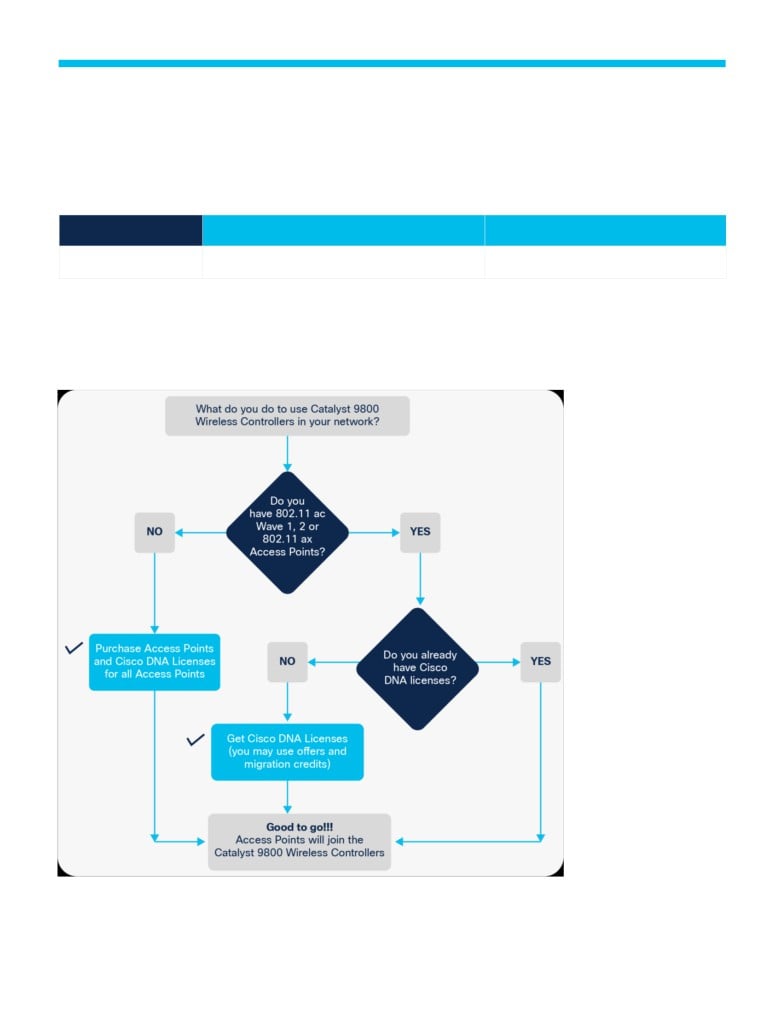
Software requirements
The Cisco Catalyst 9800-40 runs on Cisco IOS XE Software version 16.10.1 or later. This software release
includes all the features listed earlier in the Platform Benefits section.
Table 10. Minimum software requirements
Model
Description
Minimum software requirement
C9800-40-K9
Cisco Catalyst 9800-40 Wireless Controller
Cisco IOS XE Software Release 16.10.1
Licensing
No licenses are required to boot up a Cisco Catalyst 9800 Series Wireless Controller. However, in order to
connect any access points to the controller, Cisco DNA software subscriptions are required. To be entitled to
connecting to a 9800 Series controller, each access point requires a Cisco DNA subscription license.
Figure 6.
Determining license requirements for access points connecting to Cisco Catalyst 9800 Series Wireless Controllers
© 2020 Cisco and/or its affiliates. All rights reserved.
Page 17 of 20

The access points connecting to the Cisco Catalyst 9800 Series have new and simplified software subscription
packages.
They can support three tiers of Cisco DNA software: Cisco DNA Essentials, Cisco DNA Advantage and Cisco
DNA Premier.
Cisco DNA software subscriptions provide Cisco innovations on the access point. They also include perpetual
Network Essentials and Network Advantage licensing options, which cover wireless fundamentals such as
802.1X authentication, QoS and PnP; telemetry and visibility; and single sign-on, as well as security controls.
Cisco DNA subscription software has to be purchased for a 3-, 5-, or 7-year subscription term. Upon expiry of
the subscription, the Cisco DNA features will expire, whereas the Network Essentials and Network Advantage
features will remain.
For the full feature list of Cisco DNA Software, including the perpetual Network Essentials and Network
Advantage, please see the feature matrix: https://www.cisco.com/c/m/en_us/products/software/dna-
subscription-wireless/en-sw-sub-matrix-wireless.html?oid=porew018984.
Two modes of licensing are available:
● Smart Licensing (SL) simplifies and adds flexibility to licensing. It is:
◦ Simple: Procure, deploy, and manage licenses easily. Devices self-register, removing the need for
Product Activation Keys (PAKs).
◦ Flexible: Pool license entitlements in a single account. Move licenses freely through the network,
wherever you need them.
◦ Smart: Manage your license deployments with real-time visibility into ownership and consumption.
● Specific License Reservation (SLR) is a feature used in highly secure networks. It provides a method for
customers to deploy a software license on a device (product instance) without communicating usage
information to Cisco. There is no communication with Cisco or a satellite. The licenses are reserved for
every controller. It is node-based licensing.
Four levels of license are supported on the Cisco Catalyst 9800 Series Wireless Controllers. The controllers
can be configured to function at any one of the four levels.
● Cisco DNA Essentials: At this level the Cisco DNA Essentials feature set will be supported.
● Cisco DNA Advantage: At this level the Cisco DNA Advantage feature set will be supported.
● NE: At this level the Network Essentials feature set will be supported.
● NA: At this level the Network Advantage feature set will be supported.
Cisco DNA Premier is a bundle with ISE licenses and Cisco DNA Spaces Extend. It is inclusive of Cisco DNA
Advantage, so at this level the Cisco DNA Advantage feature set will be supported. For customers who
purchase Cisco DNA Essentials, Network Essentials will be supported and will continue to function even after
term expiration. And for customers who purchase Cisco DNA Advantage or Cisco DNA Premier, Network
Advantage will be supported and will continue to function even after term expiration.
Initial bootup of the controller will be at the Cisco DNA Advantage level.
For questions, contact the Cisco Catalyst 9800 Series Wireless Controllers Licensing mailer group at
ask-catalyst 9800 licensing.
© 2020 Cisco and/or its affiliates. All rights reserved.
Page 18 of 20

Managing licenses with Smart Accounts
Creating Smart Accounts by using the Cisco Smart Software Manager (SSM) enables you to order devices and
licensing packages and also manage your software licenses from a centralized website. You can set up the
Smart Account to receive daily email alerts and to be notified of expiring add-on licenses that you want to
renew. A Smart Account is mandatory for the Cisco Catalyst 9800 Series. For more information on Smart
Account refer to https://www.cisco.com/go/smartaccounts.
Warranty
Cisco 1-year limited hardware warranty terms
The following are terms applicable to your hardware warranty. Your embedded software is subject to the Cisco
EULA (link available below) and/or any SEULA or specific software warranty terms for additional software
products loaded on the device.
Duration of hardware warranty: One (1) year.
Replacement, repair, or refund procedure for hardware: Cisco or its service center will use commercially
reasonable efforts to ship a replacement part within ten (10) working days after receipt of the Return Materials
Authorization (RMA) request. Actual delivery times may vary depending on customer location.
Cisco reserves the right to refund the purchase price as its exclusive warranty remedy.
Cisco environmental sustainability
Information about Cisco’s environmental sustainability policies and initiatives for our products, solutions,
operations, and extended operations or supply chain is provided in the “Environment Sustainability” section of
Reference links to information about key environmental sustainability topics (mentioned in the “Environment
Sustainability” section of the CSR Report) are provided in the following table:
Table 11. Links to sustainability information
Sustainability topic
Reference
Information on product material content laws and regulations
Information on electronic waste laws and regulations, including products, batteries, and
packaging
Sustainability inquiries
Contact:
Cisco makes the packaging data available for informational purposes only. It may not reflect the most current
legal developments, and Cisco does not represent, warrant, or guarantee that it is complete, accurate, or up to
date. This information is subject to change without notice.
© 2020 Cisco and/or its affiliates. All rights reserved.
Page 19 of 20

Ordering information
Table 12. Ordering information
Type
Product ID
Description
Controller
C9800-40-K9
Cisco Catalyst 9800-40 Wireless Controller
LIC-C9800-DTLS-K9
Cisco Catalyst 9800 Series Wireless Controller DTLS License
Accessories, spares
C9800-AC-750W R=
Cisco Catalyst 9800-40 750W AC Power Supply Reverse Air
Cisco Capital
Flexible payment solutions to help you achieve your objectives
Cisco Capital® makes it easier to get the right technology to achieve your objectives, enable business
transformation and stay competitive. We can help you reduce the total cost of ownership, conserve capital, and
accelerate growth. In more than 100 countries, our flexible payment solutions can help you acquire hardware,
software, services and complementary third-party equipment in easy, predictable payments.
Learn more.
Printed in USA
C78-741545-07 06/20
© 2020 Cisco and/or its affiliates. All rights reserved.
Page 20 of 20




0 comments:
Post a Comment